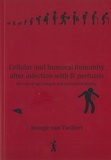Cellular and humoral immunity after infection with B. pertussis
The role of age, antigen and vaccination history
Summary
Pertussis (whooping cough), is a bacterial disease of the respiratory tract, caused by the human pathogen Bordetella pertussis. Vaccination against pertussis has dramatically lowered pertussis incidence and mortality rates; however pertussis still occurs. The duration of immunity to B. pertussis after infection is longer than after vaccination, with presently used acellular pertussis (aP) vaccines comparing less favourably than first generation whole-cell pertussis (wP) vaccines. The current upsurge of pertussis in the overall population questions the prevalence and functionality of immunity to B. pertussis throughout age groups. To study B. pertussis specific -humoral and cell mediated- immune responses, elicited by a natural infection, we set up a clinical study called the SKI study (“Specifieke Kinkhoest Immuniteit”). This study, conducted between 2008 and 2012, comprised of ~300 symptomatic (ex-) pertussis cases of all age categories, included at a known time after infection, and ~90 household controls. We aimed to profoundly extend our knowledge on waning immunity to B. pertussis and on the impact that aging and vaccination history may have.
In the field of serology, we developed a biexponential decay model to compare several infection-induced immunoglobulin (Ig) levels specific to various B. pertussis antigens (Ptx, FHA, Prn, Fim2/3 and OMV) in all SKI-cases. The decay model revealed that antigen type and age group were major factors determining variation in levels and kinetics of Ig (sub) classes. Vaccination history also played a substantial role, illustrated by poor recognition of antigens by unvaccinated (pre-) elderly and by reversed IgG3/IgG4 ratio’s in responsiveness of wP versus aP primed youngsters. Next, we asked if the prevalence of pertussis reinfections could be estimated based on single point Ig levels to Ptx in ex-symptomatic cases, years after a proven pertussis episode. We showed that an IgG-Ptx based cut-off method and a two-component mixture analysis were both unreliable for reinfection prevalence estimation. Applying a novel two-dimensional profile using both IgG-Ptx and IgA-Ptx data, a more certified reinfection prevalence was obtained, confirming that although reinfections do occur, natural pertussis infection provides (ex) cases with a relatively long period of protection to renewed infection. Our subsequent investigations addressed research questions regarding the levels, decay, specificity, functionality and age- or cohort dependency of B. pertussis specific cellular immune mechanisms, as observed after natural infection. For these studies memory B (Bmem) and T (Tmem) cells were analysed in sub-cohorts of SKI participants. Age was found to affect Bmem and Tmem cell responses differently; levels of specific Bmem cells increased with age while various functions and features of specific Tmem cells were lost with age. Remarkably, youngsters and adults being primed with wP vaccines in infancy showed similar Th1/Th2 cytokine ratio’s in their post-infection responses. An aP pre-school booster (associated with Th2 immunity) in another youngster group, also wP-primed in infancy, enhanced this ratio. The T cell responses from the aP boosted youngsters showed striking resemblances to the adult responses, indicating that both chronological age and/or a totting up of antigen exposure may drive maturation of responses that could lead to T cell exhaustion.
